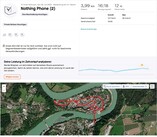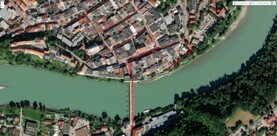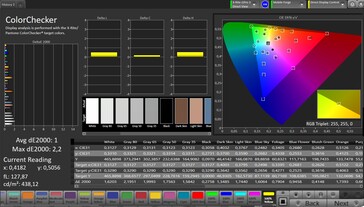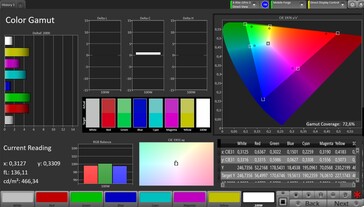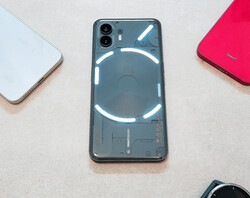Nothing Phone (2) 评测:价格合理的高端智能手机中的 LED 效果
潜在的竞争对手比较
Rating | Date | Model | Weight | Drive | Size | Resolution | Price |
|---|---|---|---|---|---|---|---|
| 87.4 % v7 (old) | 08 / 2023 | Nothing Phone (2) SD 8+ Gen 1, Adreno 730 | 201.2 g | 256 GB UFS 3.1 Flash | 6.70" | 2412x1080 | |
| 85.6 % v7 (old) | 07 / 2022 | Nothing Phone (1) SD 778G+ 5G, Adreno 642L | 193.5 g | 256 GB UFS 3.1 Flash | 6.55" | 2400x1080 | |
| 86.4 % v7 (old) | 01 / 2023 | Xiaomi 12T Dimensity 8100, Mali-G610 MP6 | 202 g | 256 GB UFS 3.1 Flash | 6.67" | 2712x1220 | |
| 86.4 % v7 (old) | 07 / 2023 | Huawei Nova 11 Pro SD 778G 4G, Adreno 642L | 188 g | 256 GB UFS 3.1 Flash | 6.78" | 2652x1200 | |
| 87 % v7 (old) | 08 / 2022 | OnePlus 10T SD 8+ Gen 1, Adreno 730 | 203.5 g | 256 GB UFS 3.1 Flash | 6.70" | 2412x1080 |
案例 - 有更多选项的字形界面
» Notebookcheck多媒体笔记本电脑Top 10排名
» Notebookcheck游戏笔记本电脑Top 10排名
» Notebookcheck低价办公/商务笔记本电脑Top 10排名
» Notebookcheck高端办公/商务笔记本电脑Top 10排名
» Notebookcheck工作站笔记本电脑Top 10排名
» Notebookcheck亚笔记本电脑Top 10排名
» Notebookcheck超级本产品Top 10排名
» Notebookcheck变形本产品Top 10排名
» Notebookcheck平板电脑Top 10排名
» Notebookcheck智能手机Top 10排名
» Notebookcheck评测过最出色的笔记本电脑屏幕
» Notebookcheck售价500欧元以下笔记本电脑Top 10排名
» Notebookcheck售价300欧元以下笔记本电脑Top 10排名
Nothing Phone (2) 比上一代产品更重、更长,但屏幕更大、性能更强。Nothing Phone(2)的两面再次由大猩猩 5 号玻璃保护,透明的背面可以看到电缆通道和无线充电螺旋。后部玻璃现在采用了弧形设计,使 Nothing Phone (2) 能够舒适地握在手中。
机身侧面采用铝制边框,棱角分明的设计和药丸状按键让人联想到当前的 iPhone。Phone (2) 有深灰色 和白色两种颜色可供选择。
做工令人满意:简洁的材料过渡和细小的缝隙营造出高品质的外观。不过,我们在评测过程中发现,智能手机长时间暴露在阳光下会变形,缝隙也会随之变大。冷却后翘曲现象会消失,但之前关于前代产品背面进水和灰尘的报道让我们感到疑惑。
外壳的防护等级为 IP54,因此与前代产品相比,防水溅性能略有提高。不过,你不应该带着 Nothing Phone (2) 去游泳。
我们喜欢 Nothing 在包装上印上设备的二氧化碳排放量,并尝试通过各种措施尽可能降低智能手机对环境的影响,如回收设备中的材料和无塑料包装。关于手机 (2) 的详细可持续发展报告,请访问网站。.
字形界面是这款智能手机的设计亮点。在透明的玻璃背面下有一个由白色 LED 灯组成的图案,可以模拟倒计时器和显示通知,Phone (2) 在这些图案的数量和功能上都有了很大的扩展。您现在可以使用 Glyph Composer 创建自己的铃声,一些第三方服务提供商(如 Uber)现在也在使用该功能,例如显示司机到达所需地点前的时间。
设备 - Nothing Phone 不支持 eSIM (2)
软件 - 也可根据要求提供无设计的软件
Nothing OS 2.0 基于Android 13,其像素化的黑白设计非常时尚,但你必须习惯没有标签的图标。喜欢经典Android 外观的用户可以在设置时选择这一选项,也可以在设置后轻松恢复,因为 Nothing OS 主要通过图标包和小工具来实现设计,用户可以随时删除或更改这些图标包和小工具。
没有预装第三方广告应用程序。我们设备上的安全补丁是从 2023 年 6 月开始的,因此在审查时仍是合理的最新版本。在我们进行评测期间,Nothing 还发布了一些小更新,并附有详细的补丁说明,以改进智能手机的功能。总体而言,这款智能手机预计将在 4 年内每 2 个月获得一次安全更新。此外,该智能手机还有 3 个新的Android 版本。
通信和全球导航卫星系统 - Nothing 手机上的快速 WiFi 6E
Nothing Phone (2) 配备了 WiFi 6E,因此可以利用较少使用的 6 GHz 频段。在使用华硕 ROG Rapture AXE11000 参考路由器进行测试时,事实证明无线局域网连接在经历了最初的困难后相当稳定,但在发送和接收数据时速度很不均匀,这一点与手机(1)如出一辙。总的来说,速度明显高于前代产品。
由于支持多种 4G 和 5G 频率,Nothing Phone (2) 可以在全球范围内使用。在我们两周的评测期间,信号质量一直很好,与其他高端智能手机不相上下。
| Networking | |
| iperf3 receive AXE11000 | |
| OnePlus 10T | |
| Xiaomi 12T | |
| Huawei Nova 11 Pro | |
| Average of class Smartphone (52 - 1721, n=177, last 2 years) | |
| iperf3 transmit AXE11000 | |
| Xiaomi 12T | |
| OnePlus 10T | |
| Huawei Nova 11 Pro | |
| Average of class Smartphone (49.8 - 1828, n=177, last 2 years) | |
| iperf3 transmit AXE11000 6GHz | |
| Nothing Phone (2) | |
| Average of class Smartphone (508 - 1945, n=94, last 2 years) | |
| Nothing Phone (1) | |
| iperf3 receive AXE11000 6GHz | |
| Average of class Smartphone (451 - 1870, n=94, last 2 years) | |
| Nothing Phone (2) | |
| Nothing Phone (1) | |
电话和语音质量 - 通过扬声器听起来更清晰
它没有使用Android 的标准电话应用程序,因此从其他品牌转过来的用户应该马上就能找到使用方法。
通话质量总体不错,但也有不足之处:内置听筒听起来有点闷,普通麦克风和免提麦克风都无法捕捉到安静的声音。如果通过扬声器与对方通话,通话听起来会清晰得多。
相机 - 改进图像质量的新型传感器
从纸面上看,这款手机的摄像头似乎没有什么变化。无手机 (1).虽然仍有两个 5000 万像素的镜头,但制造商在主摄像头上安装了更先进的索尼 IMX 890 传感器。功能更强大的 SoC 还能确保相机功能更敏捷,处理照片的速度更快。
照片第一眼看上去光线充足,色彩逼真。不过,对于较远的物体,摄像头往往会忽略细节。传感器在环境光线很弱的情况下也能拍摄出清晰的照片,但在光线很暗的地方就会失去清晰度。广角镜头也是 5000 万像素,拍摄的照片效果不错,还可以稍稍放大而不会丢失太多细节。
但缺少了更高质量相机系统所具备的真正变焦功能。Nothing Phone (2) 上没有潜望镜摄像头;最好的是混合变焦,广角和主摄像头都可以变焦。
总的来说,Nothing Phone (2) 可以拍摄出不错的照片,但视频呢?这款智能手机能以 60 fps 的速度录制 4K 视频。自动对焦和亮度调节的反应都非常迅速可靠。拍摄出的影片令人赏心悦目,尤其是在明亮的光线条件下。
前置 3200 万像素摄像头。它可以拍摄细节丰富的自拍照,还可以稍作放大,但在暗处的清晰度可以更高一些。
Image comparison
Choose a scene and navigate within the first image. One click changes the position on touchscreens. One click on the zoomed-in image opens the original in a new window. The first image shows the scaled photograph of the test device.
Main camera - flowerMain camera - surrounding environmentMain camera - low lightWide angle在实验室的全棚照明下,主相机拍摄的照片清晰度很高,只是边缘部分略有下降。我们非常喜欢照片的对比度和细节。在仅有 1 勒克斯照明的情况下,图像仍然清晰可辨,但暗部几乎没有任何清晰度。


配件和保修 - 不包括充电器
Nothing Phone (2) 不含充电器。包装盒里只有一根 USB 线和一个 SIM 卡工具。充电器可以在Nothing的网上商店购买,价格因地区而异(例如德国为35欧元)。还可购买保护套。
制造商为在欧盟购买的设备提供 24 个月的保修服务。当然,其他地区的保修期可能有所不同,因此买家在购买前应仔细确认。
输入设备和操作 - 屏幕后的指纹传感器
显示屏 - 明亮,带直流调光
| |||||||||||||||||||||||||
Brightness Distribution: 98 %
Center on Battery: 951 cd/m²
Contrast: ∞:1 (Black: 0 cd/m²)
ΔE ColorChecker Calman: 1 | ∀{0.5-29.43 Ø4.78}
ΔE Greyscale Calman: 1.6 | ∀{0.09-98 Ø5}
98.3% sRGB (Calman 2D)
Gamma: 2.203
CCT: 6516 K
| Nothing Phone (2) OLED, 2412x1080, 6.7" | Nothing Phone (1) OLED, 2400x1080, 6.6" | Xiaomi 12T AMOLED, 2712x1220, 6.7" | Huawei Nova 11 Pro OLED, 2652x1200, 6.8" | OnePlus 10T Fluid AMOLED, 2412x1080, 6.7" | |
|---|---|---|---|---|---|
| Screen | -17% | -11% | -47% | -53% | |
| Brightness middle (cd/m²) | 951 | 620 -35% | 915 -4% | 729 -23% | 861 -9% |
| Brightness (cd/m²) | 948 | 625 -34% | 914 -4% | 719 -24% | 856 -10% |
| Brightness Distribution (%) | 98 | 98 0% | 98 0% | 92 -6% | 97 -1% |
| Black Level * (cd/m²) | |||||
| Colorchecker dE 2000 * | 1 | 1.24 -24% | 1.1 -10% | 1.39 -39% | 2.27 -127% |
| Colorchecker dE 2000 max. * | 2.2 | 2.31 -5% | 2.7 -23% | 4.74 -115% | 4.17 -90% |
| Greyscale dE 2000 * | 1.6 | 1.7 -6% | 2 -25% | 2.8 -75% | 2.9 -81% |
| Gamma | 2.203 100% | 2.318 95% | 2.24 98% | 2.271 97% | 2.303 96% |
| CCT | 6516 100% | 6325 103% | 6457 101% | 6738 96% | 6141 106% |
* ... smaller is better
Screen Flickering / PWM (Pulse-Width Modulation)
| Screen flickering / PWM detected | 90 Hz | ||
The display backlight flickers at 90 Hz (worst case, e.g., utilizing PWM) . The frequency of 90 Hz is very low, so the flickering may cause eyestrain and headaches after extended use. In comparison: 53 % of all tested devices do not use PWM to dim the display. If PWM was detected, an average of 8108 (minimum: 5 - maximum: 343500) Hz was measured. | |||
在固定变焦级别和不同亮度设置下的测量系列
Display Response Times
| ↔ Response Time Black to White | ||
|---|---|---|
| 1.4 ms ... rise ↗ and fall ↘ combined | ↗ 0.7 ms rise | |
| ↘ 0.7 ms fall | ||
| The screen shows very fast response rates in our tests and should be very well suited for fast-paced gaming. In comparison, all tested devices range from 0.1 (minimum) to 240 (maximum) ms. » 7 % of all devices are better. This means that the measured response time is better than the average of all tested devices (20.2 ms). | ||
| ↔ Response Time 50% Grey to 80% Grey | ||
| 1.2 ms ... rise ↗ and fall ↘ combined | ↗ 0.6 ms rise | |
| ↘ 0.6 ms fall | ||
| The screen shows very fast response rates in our tests and should be very well suited for fast-paced gaming. In comparison, all tested devices range from 0.165 (minimum) to 636 (maximum) ms. » 4 % of all devices are better. This means that the measured response time is better than the average of all tested devices (31.6 ms). | ||
性能 - 经济型智能手机的高端动力
没有使用 2022 年的高端 SoC,即高通骁龙 8+ Gen 1、这已不再是全新的产品。这样既能降低成本,又能提供高端性能。
在基准测试中,它在同价位智能手机中的排名非常靠前,有时甚至高出一大截。在日常使用中,系统运行非常流畅,同时还为多任务处理或复杂应用(如视频编辑或无人机控制)提供了充足的性能储备。
| UL Procyon AI Inference for Android - Overall Score NNAPI | |
| Average Qualcomm Snapdragon 8+ Gen 1 (3291 - 84787, n=21) | |
| Xiaomi 12T | |
| Nothing Phone (1) | |
| Average of class Smartphone (3769 - 81594, n=135, last 2 years) | |
| Huawei Nova 11 Pro | |
| Nothing Phone (2) | |
| OnePlus 10T | |
| AImark - Score v3.x | |
| Nothing Phone (2) | |
| Huawei Nova 11 Pro | |
| Average Qualcomm Snapdragon 8+ Gen 1 (887 - 147801, n=11) | |
| Average of class Smartphone (82 - 307528, n=122, last 2 years) | |
| Xiaomi 12T | |
我们的测试设备在 GFXBench 的 4K 基准测试中达到了 20 帧/秒,因此理论上可以玩非常高分辨率的游戏,但这类游戏在 App Store 中很少。在全高清模式下,屏幕的原生分辨率为 60 帧/秒,可以顺利实现。
总之,与同类昂贵手机相比,这款智能手机的性能非常强大。
GFXBench (DX / GLBenchmark) 2.7: T-Rex Onscreen | 1920x1080 T-Rex Offscreen
GFXBench 3.0: on screen Manhattan Onscreen OGL | 1920x1080 1080p Manhattan Offscreen
GFXBench 3.1: on screen Manhattan ES 3.1 Onscreen | 1920x1080 Manhattan ES 3.1 Offscreen
GFXBench: on screen Car Chase Onscreen | 1920x1080 Car Chase Offscreen | on screen Aztec Ruins High Tier Onscreen | 2560x1440 Aztec Ruins High Tier Offscreen | on screen Aztec Ruins Normal Tier Onscreen | 1920x1080 Aztec Ruins Normal Tier Offscreen | 3840x2160 4K Aztec Ruins High Tier Offscreen
| 3DMark / Wild Life Extreme Unlimited | |
| OnePlus 10T | |
| Nothing Phone (2) | |
| Huawei Nova 11 Pro | |
| Nothing Phone (1) | |
| 3DMark / Wild Life Extreme | |
| OnePlus 10T | |
| Nothing Phone (2) | |
| Nothing Phone (1) | |
| Huawei Nova 11 Pro | |
| GFXBench (DX / GLBenchmark) 2.7 / T-Rex Onscreen | |
| Xiaomi 12T | |
| Nothing Phone (1) | |
| Huawei Nova 11 Pro | |
| OnePlus 10T | |
| Nothing Phone (2) | |
| GFXBench (DX / GLBenchmark) 2.7 / T-Rex Offscreen | |
| OnePlus 10T | |
| Nothing Phone (2) | |
| Xiaomi 12T | |
| Nothing Phone (1) | |
| Huawei Nova 11 Pro | |
| GFXBench 3.0 / Manhattan Onscreen OGL | |
| Xiaomi 12T | |
| Nothing Phone (1) | |
| OnePlus 10T | |
| Nothing Phone (2) | |
| Huawei Nova 11 Pro | |
| GFXBench 3.0 / 1080p Manhattan Offscreen | |
| OnePlus 10T | |
| Nothing Phone (2) | |
| Xiaomi 12T | |
| Nothing Phone (1) | |
| Huawei Nova 11 Pro | |
| GFXBench 3.1 / Manhattan ES 3.1 Onscreen | |
| Xiaomi 12T | |
| OnePlus 10T | |
| Nothing Phone (2) | |
| Nothing Phone (1) | |
| Huawei Nova 11 Pro | |
| GFXBench 3.1 / Manhattan ES 3.1 Offscreen | |
| OnePlus 10T | |
| Nothing Phone (2) | |
| Xiaomi 12T | |
| Nothing Phone (1) | |
| Huawei Nova 11 Pro | |
| GFXBench / Car Chase Onscreen | |
| OnePlus 10T | |
| Nothing Phone (2) | |
| Xiaomi 12T | |
| Nothing Phone (1) | |
| Huawei Nova 11 Pro | |
| GFXBench / Car Chase Offscreen | |
| OnePlus 10T | |
| Nothing Phone (2) | |
| Xiaomi 12T | |
| Nothing Phone (1) | |
| Huawei Nova 11 Pro | |
| GFXBench / Aztec Ruins High Tier Onscreen | |
| OnePlus 10T | |
| Nothing Phone (2) | |
| Xiaomi 12T | |
| Nothing Phone (1) | |
| Huawei Nova 11 Pro | |
| GFXBench / Aztec Ruins High Tier Offscreen | |
| OnePlus 10T | |
| Nothing Phone (2) | |
| Xiaomi 12T | |
| Nothing Phone (1) | |
| Huawei Nova 11 Pro | |
| GFXBench / Aztec Ruins Normal Tier Onscreen | |
| OnePlus 10T | |
| Nothing Phone (2) | |
| Xiaomi 12T | |
| Nothing Phone (1) | |
| Huawei Nova 11 Pro | |
| GFXBench / Aztec Ruins Normal Tier Offscreen | |
| OnePlus 10T | |
| Nothing Phone (2) | |
| Xiaomi 12T | |
| Nothing Phone (1) | |
| Huawei Nova 11 Pro | |
| GFXBench / 4K Aztec Ruins High Tier Offscreen | |
| OnePlus 10T | |
| Nothing Phone (2) | |
| Xiaomi 12T | |
| Nothing Phone (1) | |
| Huawei Nova 11 Pro | |
大型网站在 Nothing Phone (2) 上的加载速度非常快,在流畅滚动时通常可以看到图片。在浏览器基准测试中,测试设备领先于同类智能手机,排名第一。
| Jetstream 2 - 2.0 Total Score | |
| Nothing Phone (2) (Chrome 114) | |
| Average of class Smartphone (23.8 - 387, n=149, last 2 years) | |
| Average Qualcomm Snapdragon 8+ Gen 1 (76.2 - 204, n=23) | |
| OnePlus 10T (Chrome 104) | |
| Xiaomi 12T (Chrome 108) | |
| Huawei Nova 11 Pro (Huawei Browser 14) | |
| Nothing Phone (1) (Chrome 103) | |
| Speedometer 2.0 - Result 2.0 | |
| Average of class Smartphone (15.2 - 643, n=122, last 2 years) | |
| Nothing Phone (2) (Chrome 114) | |
| Average Qualcomm Snapdragon 8+ Gen 1 (69.1 - 196, n=18) | |
| OnePlus 10T (Chrome 104) | |
| Xiaomi 12T (Chrome 108) | |
| Huawei Nova 11 Pro (Huawei Browser 14) | |
| Nothing Phone (1) (Chome 103) | |
| WebXPRT 4 - Overall | |
| Nothing Phone (2) (Chrome 114) | |
| Average of class Smartphone (27 - 306, n=145, last 2 years) | |
| Average Qualcomm Snapdragon 8+ Gen 1 (69 - 159, n=21) | |
| Xiaomi 12T (Chrome 108) | |
| Huawei Nova 11 Pro (Huawei Browser 14) | |
| OnePlus 10T | |
| Nothing Phone (1) (Chrome 103) | |
| WebXPRT 3 - Overall | |
| Nothing Phone (2) (Chrome 114) | |
| Average of class Smartphone (38 - 380, n=31, last 2 years) | |
| Average Qualcomm Snapdragon 8+ Gen 1 (106 - 224, n=14) | |
| Xiaomi 12T (Chrome 108) | |
| Huawei Nova 11 Pro (Huawei Browser 14) | |
| OnePlus 10T (Chrome 104) | |
| Nothing Phone (1) (Chrome 103) | |
| Octane V2 - Total Score | |
| Nothing Phone (2) (Chrome 114) | |
| Average of class Smartphone (2228 - 121337, n=197, last 2 years) | |
| Average Qualcomm Snapdragon 8+ Gen 1 (17622 - 61536, n=24) | |
| OnePlus 10T (Chrome 104) | |
| Xiaomi 12T (Chrome 108) | |
| Huawei Nova 11 Pro (Huawei Browser 14) | |
| Nothing Phone (1) (Chrome 103) | |
| Mozilla Kraken 1.1 - Total | |
| Nothing Phone (1) (Chrome 103) | |
| OnePlus 10T (Chrome 104) | |
| Xiaomi 12T (Chrome 108) | |
| Huawei Nova 11 Pro (Huawei Browser 14) | |
| Average of class Smartphone (257 - 28190, n=154, last 2 years) | |
| Average Qualcomm Snapdragon 8+ Gen 1 (665 - 1707, n=22) | |
| Nothing Phone (2) (Chrome 114) | |
* ... smaller is better
UFS 3.1 内存通常出现在 750 美元左右的智能手机中,但 Nothing Phone (2) 的内存控制器也能很好地完成任务。因此,加载时间短,数据传输快。
| Nothing Phone (2) | Nothing Phone (1) | Xiaomi 12T | Huawei Nova 11 Pro | OnePlus 10T | Average 256 GB UFS 3.1 Flash | Average of class Smartphone | |
|---|---|---|---|---|---|---|---|
| AndroBench 3-5 | -22% | 10% | -35% | -38% | -13% | 6% | |
| Sequential Read 256KB (MB/s) | 1949.5 | 1638 -16% | 1834.32 -6% | 1009.1 -48% | 1568.37 -20% | 1757 ? -10% | 2228 ? 14% |
| Sequential Write 256KB (MB/s) | 1517.6 | 1351.9 -11% | 1768.39 17% | 809 -47% | 847.69 -44% | 1204 ? -21% | 1851 ? 22% |
| Random Read 4KB (MB/s) | 287.5 | 240.6 -16% | 342.8 19% | 229.8 -20% | 173.45 -40% | 287 ? 0% | 296 ? 3% |
| Random Write 4KB (MB/s) | 403.8 | 228.2 -43% | 437.07 8% | 303 -25% | 211.24 -48% | 318 ? -21% | 337 ? -17% |
游戏 - 60 fps 绝对可能
虽然 Nothing Phone (2) 并不是一款指定的游戏手机,但在所有测试游戏中,即使在高设置下,它仍能达到 60 帧/秒。
由于帧率非常稳定,即使是要求更高的游戏玩家也能在这款智能手机上玩得很好。遗憾的是,120 Hz 的最大屏幕几乎无法使用。帧频是通过GameBench软件进行测量。
在我们的测试中,通过触摸屏和内置位置传感器进行控制的效果非常好。
排放 - 加热和节流
温度
在长时间负载情况下,我们测得的最高机箱温度为 45.8 °C。这一点很明显,但并不严重。在日常使用中,温度通常会较低,但长时间游戏肯定会导致温度明显升高。
在长时间负载情况下,处理器也会出现明显的节流现象,有时在运行 20 次基准测试后,只能提供初始性能的 60%。
(-) The maximum temperature on the upper side is 45.8 °C / 114 F, compared to the average of 35.2 °C / 95 F, ranging from 21.9 to 247 °C for the class Smartphone.
(±) The bottom heats up to a maximum of 42.1 °C / 108 F, compared to the average of 34 °C / 93 F
(+) In idle usage, the average temperature for the upper side is 28.6 °C / 83 F, compared to the device average of 32.9 °C / 91 F.
3DMark Wild Life Stress Test
| 3DMark | |
| Wild Life Stress Test Stability | |
| Nothing Phone (1) | |
| Huawei Nova 11 Pro | |
| OnePlus 10T | |
| Nothing Phone (2) | |
| Wild Life Extreme Stress Test | |
| Nothing Phone (1) | |
| Nothing Phone (2) | |
| OnePlus 10T | |
发言人
听筒在 Nothing Phone (2) 上被用作第二个扬声器,因此只要位置正确,就能产生轻微的立体声效果,整体音效也会稍强一些。扬声器的音量适中,重现音乐的效果相当清晰。
不过,这款智能手机听起来还是有些高音偏重,因此真正的音频发烧友最好还是使用耳机或外置扬声器。在无线音频编解码方面,从 SBC、AAC、aptX、aptX HD、aptX Adaptive、aptX TWS+、LDAC、LHDC 到 V5,几乎应有尽有。
Nothing Phone (2) audio analysis
(±) | speaker loudness is average but good (81.9 dB)
Bass 100 - 315 Hz
(-) | nearly no bass - on average 28.5% lower than median
(±) | linearity of bass is average (10.1% delta to prev. frequency)
Mids 400 - 2000 Hz
(±) | higher mids - on average 6.3% higher than median
(+) | mids are linear (6.5% delta to prev. frequency)
Highs 2 - 16 kHz
(+) | balanced highs - only 4.2% away from median
(+) | highs are linear (5.3% delta to prev. frequency)
Overall 100 - 16.000 Hz
(±) | linearity of overall sound is average (23.5% difference to median)
Compared to same class
» 53% of all tested devices in this class were better, 8% similar, 39% worse
» The best had a delta of 11%, average was 35%, worst was 134%
Compared to all devices tested
» 69% of all tested devices were better, 6% similar, 24% worse
» The best had a delta of 4%, average was 24%, worst was 134%
OnePlus 10T audio analysis
(+) | speakers can play relatively loud (84 dB)
Bass 100 - 315 Hz
(-) | nearly no bass - on average 68.4% lower than median
(+) | bass is linear (0% delta to prev. frequency)
Mids 400 - 2000 Hz
(-) | nearly no mids - on average 68.4% lower than median
(+) | mids are linear (0% delta to prev. frequency)
Highs 2 - 16 kHz
(-) | nearly no highs - on average 68.4% lower than median
(+) | highs are linear (0% delta to prev. frequency)
Overall 100 - 16.000 Hz
(-) | overall sound is not linear (124.4% difference to median)
Compared to same class
» 94% of all tested devices in this class were better, 5% similar, 1% worse
» The best had a delta of 11%, average was 35%, worst was 134%
Compared to all devices tested
» 98% of all tested devices were better, 2% similar, 0% worse
» The best had a delta of 4%, average was 24%, worst was 134%
电池寿命 - 日常使用相当持久
耗电量
Nothing Phone (2) 的耗电量在空载或低负载时相当不错,但在最大负载时会急剧增加,耗电量非常高。
如果必须将智能手机插上电源,充电功率可达 45 瓦,但不包括合适的充电器。在我们的测试实验室中,智能手机可以顺利接受大多数充电器,在满负荷充电的情况下,最多 1:30 小时即可充满电。无线充电的功率可达 15 瓦,从其他设备反向充电的功率为 5 瓦。
| Off / Standby | |
| Idle | |
| Load |
|
Key:
min: | |
| Nothing Phone (2) 4700 mAh | Nothing Phone (1) 4500 mAh | Xiaomi 12T 5000 mAh | OnePlus 10T 4800 mAh | Average Qualcomm Snapdragon 8+ Gen 1 | Average of class Smartphone | |
|---|---|---|---|---|---|---|
| Power Consumption | 4% | -19% | 16% | -23% | -18% | |
| Idle Minimum * (Watt) | 0.9 | 1 -11% | 1.38 -53% | 0.8 11% | 1.006 ? -12% | 0.842 ? 6% |
| Idle Average * (Watt) | 1.1 | 1.2 -9% | 1.83 -66% | 1.2 -9% | 1.834 ? -67% | 1.439 ? -31% |
| Idle Maximum * (Watt) | 1.4 | 1.5 -7% | 1.9 -36% | 1.3 7% | 1.984 ? -42% | 1.624 ? -16% |
| Load Average * (Watt) | 5 | 4.2 16% | 3.23 35% | 3.5 30% | 5.68 ? -14% | 7.03 ? -41% |
| Load Maximum * (Watt) | 10.4 | 7.4 29% | 7.71 26% | 5.9 43% | 8.44 ? 19% | 11.3 ? -9% |
* ... smaller is better
Power consumption: Geekbench (150 cd/m²)
Power consumption: GFXBench (150 cd/m²)
电池寿命
Nothing Phone (2) 配备了 4,700 毫安时的强力电池,在我们的 Wi-Fi 测试中可确保长达 15:09 小时的稳定运行时间。小米 12T 的续航时间要长得多,而 Nothing 手机(1)也能多上网几分钟,但 Phone (2) 的续航时间足以满足日常使用。
| Nothing Phone (2) 4700 mAh | Nothing Phone (1) 4500 mAh | Xiaomi 12T 5000 mAh | Huawei Nova 11 Pro 4500 mAh | OnePlus 10T 4800 mAh | |
|---|---|---|---|---|---|
| Battery runtime | -4% | -6% | -24% | 13% | |
| Reader / Idle (h) | 29.1 | 30.2 4% | 26.3 -10% | 29.9 3% | |
| H.264 (h) | 20.8 | 17.7 -15% | 17.1 -18% | 27.4 32% | |
| WiFi v1.3 (h) | 15.2 | 15.4 1% | 16.4 8% | 11.5 -24% | 14.3 -6% |
| Load (h) | 4.5 | 4.3 -4% | 4.3 -4% | 5.5 22% |
Pros
Cons
结论 - 异常超值
Nothing Phone (2) 的最便宜版本已经上市,售价为 749 美元,对于配备高端 SoC 的智能手机来说,这绝对是一个不错的价格。毕竟,它还拥有良好的电池续航能力、近 1000 cd/m² 的高亮度 OLED 屏幕(带直流调光功能)和非常出色的色彩还原能力,以及快速充电技术和无线充电功能。
操作系统也可以在没有制造商设计的情况下运行,并计划在 4 年内接受安全更新。多种手机频率意味着这款智能手机可以在全球范围内使用,而且摄像头的拍照效果也不错。虽然质量比不上高端相机,也缺少光学变焦功能,但如果你只想拍摄色彩自然、清晰的照片,Nothing Phone (2) 是一个不错的选择。
半透明的设计依然引人注目,字形界面也是一个不错的噱头,用途越来越多。
Nothing Phone(2)没有配备充电器,你可能会觉得有用,也可能觉得没有必要,但不支持 eSIM 卡确实令人讨厌。蹩脚的 USB 2.0 端口无法通过端口转发视频,这也不应该出现在高端智能手机中。
Nothing Phone (2) 速度很快,设计独特,功能高端,价格合理。
如果你喜欢中端性能和 Glyph 界面,你可以花 405 美元购买 Nothing Phone (1)美国亚马逊。一加手机 一加 10T速度也非常快,而且价格便宜。
价格和供应情况
Nothing Phone (2)
- 07/26/2023 v7 (old)
Florian Schmitt
Transparency
The selection of devices to be reviewed is made by our editorial team. The test sample was provided to the author as a loan by the manufacturer or retailer for the purpose of this review. The lender had no influence on this review, nor did the manufacturer receive a copy of this review before publication. There was no obligation to publish this review. As an independent media company, Notebookcheck is not subjected to the authority of manufacturers, retailers or publishers.
This is how Notebookcheck is testing
Every year, Notebookcheck independently reviews hundreds of laptops and smartphones using standardized procedures to ensure that all results are comparable. We have continuously developed our test methods for around 20 years and set industry standards in the process. In our test labs, high-quality measuring equipment is utilized by experienced technicians and editors. These tests involve a multi-stage validation process. Our complex rating system is based on hundreds of well-founded measurements and benchmarks, which maintains objectivity. Further information on our test methods can be found here.





















